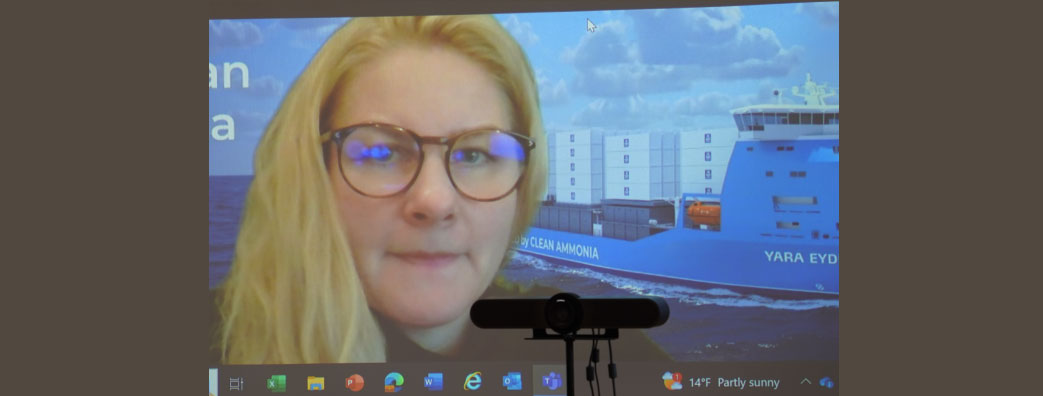On 20 November, the Green Platform project Ammonia Fuel Bunkering Network (AFBN) held a seminar in Trondheim. With 20 participants, the purpose was information exchange on current activities, and to report on the overall status.
Led by AZANE Fuel Solutions, the AFBN aims to realise an ammonia (NH3) fuel value chain for the first ammonia-fueled ships, including the development of the world’s first NH3 bunkering network. In the intertwined competence development project (KSP) MaritimeNH3, SINTEF is developing knowledge to facilitate a safe and cost-efficient implementation of NH3 as a maritime fuel.
MaritimeNH3 Project Manager Cecilia Gabrielii (SINTEF Energy Research) welcomed the participants and emphasised the importance of effective information exchanges. She referred to a long list of newsclips related to the current developments and results within the use of “ammonia as maritime fuel”. Her main message was that the AFBN’s activities respond to the opportunities in a very rapid and timely manner, and that prospects are bright. She complemented the industry partners for the speed in their undertakings.
Choice of propulsion/power generation on Viridis’ vessels
Karl Fredrik Vistad, Amon Maritime
Karl Fredrik presented Viridis’ development of the world’s first ammonia-powered short-sea bulk vessel. Viridis’ strategy is to develop, build, and operate their own zero-carbon bulk carriers. The work started in 2020, and now at the end of 2023, the main ship design has been completed, and construction can start. The vessels will bunker refrigerated ammonia from the floating terminals developed under the AFBN.
The dual fuel engines from Wärtsilä can operate on both ammonia and marine diesel oil. In the first phase, when burning ammonia, biodiesel is used as a pilot fuel (for ignition). This makes the vessel 70-85% “carbon free” and 100% “carbon neutral”. In the second phase, the plan is to use the same engines, but a cracker will be included to replace the biodiesel with hydrogen, in order to achieve 100% carbon free operation. The development is supported by Enova SF with NOK 152 million. Viridis Bulk Carriers AS was established in 2020 by Navigare Logistics, Amon Maritime and Mosvolds Rederi.
NH3 combustion simulations
Andrea Gruber, SINTEF Energy Research (on video link from Tokyo)
Andrea reported that ammonia-fired internal combustion engines are currently being rapidly developed, and different combustion technologies and engine design strategies are possible. Some manufacturers are developing diesel-piloted, compression-ignition engines with dual-fuel capabilities, while others have tested port-injected, spark-ignited engines with satisfactory outcome. Currently, the preferred direction is still unclear.
Andrea’s project deals with engines that do not need to use a pilot fuel. The work focuses on three activities: advanced numerical simulations to get fundamental insights into the combustion process and emissions of nitrogen oxides (NOx) and nitrous oxide (N2O), simulations of realistic combustion chamber geometries, and developing hydrogen-fired pre-chambers.
Andrea said the chemical kinetics of ammonia flames still represent an uncertainty and experiments at Tohoku University (Japan) are ongoing for model validation purposes. He noted that a comparative study of fuel injection strategies will be completed next year, in collaboration with HYDROGENi, a research and innovation centre for hydrogen and ammonia.
Ammonia-to-power unit
Erik Orrebakken, Amogy
Headquartered in Brooklyn, NY, Amogy was founded in November 2020, and has around 190 employees worldwide. The European headquarters is located in Stavanger, and the company opened their Stord Test Center in 2023, where they are currently conducting full-scale testing of their ammonia-to-power product. In June, they received their first pre-order from a Norwegian ship-owner.
Amogy’s product, the Amogy PowerPack can be delivered in a containerised solution. It consists of three modules, a reactor, an adsorber, and a fuel cell (proton exchange membrane, PEM), and has a capacity of 200 kW. On their way to realising this unit, the company has demonstrated three ammonia powerpacks – for a drone (5 kW, 3 hrs operation), for a tractor (100 kW), and for a semi-truck (300 kW, 10 hrs operation). Next, they will demonstrate a 1 MW (12 hrs operation) tugboat, starting early 2024. The fuel-to-power system efficiency (NH3 to electricity) for all systems is about 40%.
Experimental work on NH3-fuelled SOFC
Vegar Øygarden, SINTEF Industry
Two principally different types of fuel cells can be used with ammonia as fuel in maritime applications – proton-exchange membrane fuel cells (PEMFC) and solid oxide fuel cells (SOFC). PEMFCs are regarded as mature technology, while SOFCs need more R&D. SOFCs have a higher electrical efficiency and are fuel flexible. With far higher operating temperatures (600-800°C) than the PEMFCs (around 80°C), degradation of the fuel cell is a potential challenge. On the other hand, this allows for the possibility of waste heat recovery.
Central issues in Vegard’s investigations are the electrochemical performance characteristics of NH3-fueled SOFCs, and potential problems with degradation. Vegard said that the tests conducted so far indicate that the performance of single-cell commercial SOFCs fuelled by ammonia is comparable to those fuelled by hydrogen. Furthermore, there are no indications of degradation in electrochemical performance, microstructure, or nitridation of nickel within the SOFC. However encouraging preliminary results, Vegard underlined that it is still important to conduct long-term testing (>1000 hrs), and to establish a full mapping of electrochemical performance under realistic loads.
SP2 Value chain integration – choice of pilot locations
Marthe Solaas, Yara Clean Ammonia (on video link)
Yara Clean Ammonia (YCA) has an agreement with Azane Fuel Solutions to establish a bunkering barge in Norway, to be operational in 2025. The top barge locations identified in the project are at Florø, Porsgrunn area, Stavanger area, Karmsund, and Mongstad. The Florø barge terminal is approved by DSB and is now on public hearing. Yara has conducted analyses of what will happen in case of a leakage. The safety level is satisfactory and within regulations.
YCA has established a partnership with the Norwegian container operator North Sea Container Line to construct the container vessel Yara Eyde. This is an ammonia-fuelled container vessel that will trade on a weekly roundtrip from the Oslo Fjord to the German North Sea area, building up a green value chain. The vessel will run on renewable, low-carbon ammonia, and is estimated to be delivered from the shipyard in 2026.
Marte pointed to the several challenges observed in the project. The application processes are long and tedious, the market is maturing at a slow rate, and knowledge about NH3 spreads slowly. On the positive side, the technical barriers have been overcome, the interest from ship owners is increasing, and there is positive progress in terms of developing regulations.
NH3 production – Impact of H2 source and delivery state on process parameters
Elettra Vantaggiato, SINTEF Energy Research
The objective of this work is to develop an optimisation methodology for a techno-economic and GHG assessment of a Norwegian ammonia-based energy system, and compare it to alternative hydrogen-based value chains. A central issue is to identify cost-effective solutions for the production, distribution and consumption of ammonia in the Norwegian maritime sector.
Elettra gave a thorough explanation of a novel approach to modelling the ammonia production process. The model has been developed and analysed with ASPEN HYSYS and a Python code. It enables the energy demands and impact of operating conditions to be evaluated, and will be used to provide input for techno-economic analysis. This approach allows us to keep our eyes on the future, considering the impact of new technologies for the raw materials production and new applications for the produced ammonia.
Modelling and analysis of Norwegian NH3 value chain
Miguel Muñoz Ortiz, SINTEF Industry
Miguel presented a case analysis where the aim is to predict needs for investments, power consumption, emissions, and other factors in the Norwegian ammonia value chain. In the study, Norway is divided into five regions and each region is analysed in five-year intervals from 2030 to 2050. It is assumed that the demand for ammonia in maritime transport in Norway will start in 2023 with 6,000 tonnes/year and increase to around 475,000 tonnes/year in 2050.
The preliminary conclusions are: 1) Production should mainly be centralised, and initially located either in northern Norway or on the west coast. 2) The relatively low ammonia demand in the early stages makes it difficult to fully utilise the plant capacity. 3) Storage and bunkering are difficult to evaluate with the spatial and temporal resolutions applied in the analysis. 4) The effect of transport is relatively low on the cost side but has an important effect on emissions.
AFBN bunkering concept – description and challenges
Martin Cato Pettersen, AZANE Fuel Solutions
AZANE focuses on developing a value chain for ammonia that includes bunkering facilities. The AFBN concept is a “non-self-propelled” bunkering barge, designed for refrigerated liquid ammonia storage at -33°C. The ammonia will be supplied by ship or truck to the barge, which is fixed at the bunkering location, but can be towed or pushed for relocation. Loading and unloading is done by using a flexible cooling and vapor handling system. Dimensions of the barge are 47x13m (length x width), the bunkering capacity is 250 m3/hr, and the ammonia tank itself is 1000 m3. Subject to necessary approvals, construction is scheduled to start in early 2024.
Modelling of Ammonia dispersion
Hans Langva Skarsvåg, SINTEF Energy Research
The objective is to improve NH3 dispersion modelling, with the goal of increasing safety in the vicinity of NH3 bunkering installations. Simulation models, both CFD and simpler models, are developed to understand the potential consequences of leakages. This includes, for example, fog formation and resulting safety distances, as dangerous concentrations can occur under varying wind conditions and air humidity. Investigations have been focused on refrigerated ammonia storage at close to atmospheric pressure, which will be the case for the AFBN concept.
Hans said that a binary droplet formation model has been developed for ammonia in humid air. This enables more accurate simulations of ammonia evaporation clouds in humid air. It is found that droplet formation plays an important role, indicating that the risk for dangerous ammonia concentrations is smaller in humid air. Further activities include scenario modelling and studying effects of the transient nature of spills and evaporation. As a response to questions from industry related to ammonia spills in water, Hans mentioned that this is the focus of a new SINTEF-led KSP project (SafeAm).
Summary of AFBN status
Steinar Kostøl, AZANE Fuel Solutions
Steinar, the project manager of the AFBN, highlighted the main goal of the project: to realise an ammonia fuel value chain for the first ammonia-fuelled ships. Activities are divided into four sub-projects: 1) Flexible bunkering hub, technology development, 2) Value chain integration – ammonia supply, distribution and end users, 3) Safety, rules/regulations and procedures, and 4) Ammonia fuel bunkering hub construction & pilot.
In terms of technology, AZANE is now working on finalising all pre-contract engineering activities. Construction is expected to commence in the first quarter of 2024. In the value chain project, different locations for bunkering terminals along the Norwegian south and west coast have been evaluated. Risks have been assessed to satisfaction, and a hearing is in progress. Final approval by DSB Fjord Base and Municipality, and additional location approvals, are still pending. The AFBN project is on schedule and have completed most of the planned activities in 2023.
Other NH3-projects/activities at SINTEF
Ida Hjorth, SINTEF Energy Research
Ida discussed other activities at SINTEF related to ammonia as fuel for various applications. Ongoing projects include the petroleum research centre LowEmission and the research centre for environment-friendly energy (FME) HYDROGENi. The recently granted projects she mentioned included the EU project SINGLE, and the KSP projects DECAMMP and SafeAm (both funded by the Research Council of Norway).
SINGLE is demonstrating ammonia-to-hydrogen conversion through the use of proton ceramic electrochemical reactors. DECAMMP is developing conceptual design and operational strategies to enable the use of NH₃/H₂ blends for carbon-free offshore power generation. SafeAm sets out to investigate safety aspects of ammonia spills on and into water. She also mentioned that SINTEF last week submitted a proposal to the RCN for a new FME, entitled MarTrans (maritime energy transition). This project has four research areas: Energy efficient shipping, Onboard energy systems, Port infrastructure for green energy, and Sustainable transition pathways. If granted, this project will start early 2025.
To conclude, Cecilia ended the meeting expressing admiration to the AFBN team for their achievements in a very short period. She thanked all presenters for interesting and excellent presentations, and encouraged all participants to start considering relevant activities in a potential continuation of the project.













0 comments on “Ammonia Fuel Bunkering Network project making rapid progress”